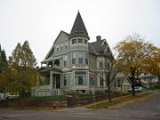
Irvine Park Historic District
Encyclopedia
Irvine Park is a neighborhood just west of downtown Saint Paul, Minnesota
that contains a number of historic homes. The neighborhood was plat
ted by John Irvine and Henry Mower Rice in 1849. At the center of the neighborhood is Irvine Park, a New England
-style public square
. The neighborhood is a district listed on the National Register of Historic Places
and also designated by the city as a historic district.
The neighborhood suffered for much of the twentieth century. A report on housing from the 1930s characterized the area as being
In 1970, 96 percent of the neighborhood's houses were classified as substandard by the city. In the early 1970s the city planned to tear down the area and replace it with high-rise apartments for public housing. The neighborhood became a National Register Historic District in 1973 and was named Saint Paul Heritage Preservation District in 1982.
Saint Paul, Minnesota
Saint Paul is the capital and second-most populous city of the U.S. state of Minnesota. The city lies mostly on the east bank of the Mississippi River in the area surrounding its point of confluence with the Minnesota River, and adjoins Minneapolis, the state's largest city...
that contains a number of historic homes. The neighborhood was plat
Plat
A plat in the U.S. is a map, drawn to scale, showing the divisions of a piece of land. Other English-speaking countries generally call such documents a cadastral map or plan....
ted by John Irvine and Henry Mower Rice in 1849. At the center of the neighborhood is Irvine Park, a New England
New England
New England is a region in the northeastern corner of the United States consisting of the six states of Maine, New Hampshire, Vermont, Massachusetts, Rhode Island, and Connecticut...
-style public square
Public Square
Public Square is the central plaza in downtown Cleveland, Ohio, United States. It takes up four city blocks; Superior Avenue and Ontario Street cross through it. Cleveland's three tallest buildings, Key Tower, 200 Public Square and the Terminal Tower, face the square...
. The neighborhood is a district listed on the National Register of Historic Places
National Register of Historic Places
The National Register of Historic Places is the United States government's official list of districts, sites, buildings, structures, and objects deemed worthy of preservation...
and also designated by the city as a historic district.
The neighborhood suffered for much of the twentieth century. A report on housing from the 1930s characterized the area as being
... in the less desirable rooming-house district; old homes, that at one time were mansions, but, over a period of years have been out-moded. Each successive tenant has been a little less able to pay adequate rent until the present occupants have commercialized the homes in one form or another.
In 1970, 96 percent of the neighborhood's houses were classified as substandard by the city. In the early 1970s the city planned to tear down the area and replace it with high-rise apartments for public housing. The neighborhood became a National Register Historic District in 1973 and was named Saint Paul Heritage Preservation District in 1982.
Houses in the district
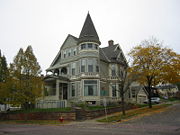 |
The Murray-Lanpher House was designed by Edward P. Bassford in 1886. Architectural critic Larry Millett Larry Millett Larry Millett is an American journalist and author. He is the former architectural critic for the St. Paul Pioneer Press, a daily newspaper in St. Paul, Minnesota, and the author of several books on the history of architecture in Minnesota... writes, "This is probably what most people have in mind when they dream of a Queen Anne house." |
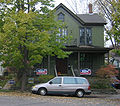 |
The Jay and Henry Knox House was built in 1860 by two brothers who were bankers. This is one of the few Carpenter Gothic Carpenter Gothic Carpenter Gothic, also sometimes called Carpenter's Gothic, and Rural Gothic, is a North American architectural style-designation for an application of Gothic Revival architectural detailing and picturesque massing applied to wooden structures built by house-carpenters... houses in the Twin Cities. The vertical board and batten siding, a trademark of the style, was covered beneath stucco Stucco Stucco or render is a material made of an aggregate, a binder, and water. Stucco is applied wet and hardens to a very dense solid. It is used as decorative coating for walls and ceilings and as a sculptural and artistic material in architecture... until its new owners began restoring the house in the 1970s. |
 |
The Parker-Marshall House, a Greek Revival design, is the oldest house on the park, built in 1852. It was originally located where the Murray-Lanpher House is now, then was moved to an adjoining lot in 1883 and then moved to its current site in 1976. |
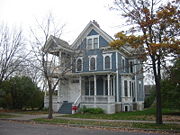 |
The John McDonald House is an Italianate design from 1873. It was moved from its original location on Smith Avenue in 1878. A local legend states that the house is the only house in St. Paul history to receive a parking ticket when the structure was parked in the street overnight in the process of moving it. |
 |
The Justus Ohage House is a Romanesque Revival design with Germanic features from 1889. The house was supposedly designed to resemble the childhood home of his wife Augusta from when she grew up in St. Louis, Missouri St. Louis, Missouri St. Louis is an independent city on the eastern border of Missouri, United States. With a population of 319,294, it was the 58th-largest U.S. city at the 2010 U.S. Census. The Greater St... . Unfortunately, Augusta died at age 34 just a few weeks after the house was finished. Dr. Ohage raised the couple's five children and made several other accomplishments, such as establishing St. Paul's public health Public health Public health is "the science and art of preventing disease, prolonging life and promoting health through the organized efforts and informed choices of society, organizations, public and private, communities and individuals" . It is concerned with threats to health based on population health... service, built public bathhouses at Harriet Island before donating the land to the city, and performed the first successful gall bladder operation in the United States in 1886. |
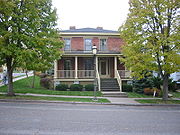 |
The Simpson-Wood House is a simple Federal Style house that was originally built in 1853 and located on Sherman Street before being moved to Irvine Park in 1978. |
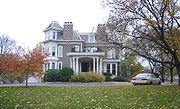 |
The Joseph Forepaugh House, now known as Forepaugh's Restaurant, was built by a dry goods Dry goods Dry goods are products such as textiles, ready-to-wear clothing, and sundries. In U.S. retailing, a dry goods store carries consumer goods that are distinct from those carried by hardware stores and grocery stores, though "dry goods" as a term for textiles has been dated back to 1742 in England or... dealer who supplied troops during the American Civil War American Civil War The American Civil War was a civil war fought in the United States of America. In response to the election of Abraham Lincoln as President of the United States, 11 southern slave states declared their secession from the United States and formed the Confederate States of America ; the other 25... and made enough money to retire at age 34. The house dates back to 1870. |
 |
The Alexander Ramsey House Alexander Ramsey House The Alexander Ramsey House, located at 265 Exchange Street, South in Saint Paul, Minnesota is the former residence of Alexander Ramsey, who served as the first governor of Minnesota Territory and the second governor of the state of Minnesota.... is located across Exchange Street from the Irvine Park public square. It was the residence of Alexander Ramsey Alexander Ramsey Alexander Ramsey was an American politician. He was born near Harrisburg, Pennsylvania.Alexander Ramsey was elected from Pennsylvania as a Whig to the U.S. House of Representatives and served in the 28th and 29th congresses from March 4, 1843 to March 4, 1847... , the first governor of Minnesota Territory Minnesota Territory The Territory of Minnesota was an organized incorporated territory of the United States that existed from March 3, 1849, until May 11, 1858, when the eastern portion of the territory was admitted to the Union as the State of Minnesota.-History:... and the second governor of the state of Minnesota Minnesota Minnesota is a U.S. state located in the Midwestern United States. The twelfth largest state of the U.S., it is the twenty-first most populous, with 5.3 million residents. Minnesota was carved out of the eastern half of the Minnesota Territory and admitted to the Union as the thirty-second state... . The house was built in 1872 in the French Second Empire style. It is now owned by the Minnesota Historical Society Minnesota Historical Society The Minnesota Historical Society is a private, non-profit educational and cultural institution dedicated to preserving the history of the U.S. state of Minnesota. It was founded by the territorial legislature in 1849, almost a decade before statehood. The Society is named in the Minnesota... , which now operates it as a museum. |
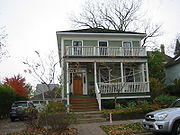 |
The Charles Symonds House was built in 1850 and is thought to be St. Paul's oldest house. It was built by Charles Symonds, a former sea captain, and originally located across the street and just to the east. |
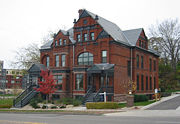 |
The Armstrong House was originally located at 233-235 West Fifth Street in downtown. It was built in 1886 and designed by Edward Bassford, with a number of Victorian details. The state purchased it in 1988 for possible use as an arts high school, but the plan fell through and the house was left vacant for 13 years. The house was moved to its current site at 223-229 Eagle Parkway in 2001 and is now home to four condominiums. |
Further reading
- Stumm, Robert J., "Irvine Park in 1854: Its Homes and the People Who Lived There 150 Years Ago, Ramsey County History Quarterly V39 #1, Ramsey County Historical Society,St Paul, MN, 2004.

